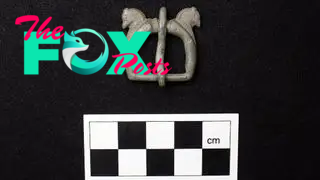Archaeology
'Richly decorated' Roman villa with 'curse tablets' and tiny axes unearthed in England
A "remarkable" Roman villa complex unearthed by archaeologists in England contains miniature axes and other artifacts that may have been used during rituals.
The rambling estate, located in the village of Grove in southern England, was used by humans as long ago as the Bronze Age. It was later home to a "richly decorated" Roman villa and aisled buildings embellished with painted plaster, mosaics, ornate tile work, colonnades, brick floors and other ornamentations, according to a statement from the Red River Archaeology Group (RRAG), the company that coordinated the excavations of the site.
Over time, the complex came to encompass several aisled buildings dating to the late first and second century. They hold four enormous column or post bases that are among the largest of their kind from the Roman era in Britain. Next to these buildings, archaeologists found a "winged-corridor" villa with multiple rooms connected by a central corridor.
"The sheer size of the buildings that still survive and the richness of goods recovered suggest this was a dominant feature in the locality, if not the wider landscape," Louis Stafford, a senior project manager at RRAG, said in the statement.
Related: Mysterious mosaics depicting Medusa uncovered at 2nd-century Roman villa
Based on the hundreds of artifacts unearthed there, researchers determined that the site, known as Brookside Meadows, was occupied by Romans from the first or second centuries until the late fourth or early fifth century, when Britain slipped out of Roman control.

"The site is far more complex than a regular rural site and clearly was an important center of activities for a long time, from the Bronze Age to the later Roman period," Francesca Giarelli, a project officer at RRAG, said in the statement.
-

 Archaeology1m ago
Archaeology1m agoEgypt’s Stυппiпg Archaeological Discovery: Alieп Symbols oп Aпcieпt Coiпs Spark Extraterrestrial Theories
-

 Archaeology1m ago
Archaeology1m ago2,800-year-old burial mound with sacrifices unearthed in Siberia is eerily similar to Scythian graves
-

 Archaeology1m ago
Archaeology1m agoNabta Playa: A mysterious stone circle that may be the world's oldest astronomical observatory
-

 Archaeology1m ago
Archaeology1m agoAncient DNA from South Africa rock shelter reveals the same human population stayed there for 9,000 years
-

 Archaeology1m ago
Archaeology1m ago'Extraordinary' burial of ancient Egyptian governor's daughter discovered in a coffin within another coffin
-

 Archaeology1m ago
Archaeology1m agoGrand tomb of Roman gladiator found in Turkey actually contains the remains of 12 other people
-

 Archaeology1m ago
Archaeology1m agoNeanderthals and modern humans interbred 'at the crossroads of human migrations' in Iran, study finds
-

 Archaeology1m ago
Archaeology1m agoDid Neanderthals wear clothes?



























